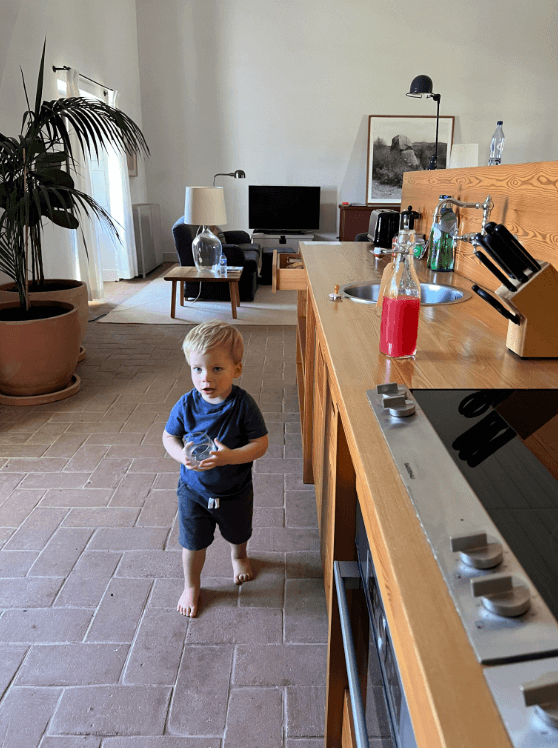Table of Contents
Traveling with kids is one of the best ways to see the world—but let’s be honest, it’s not always easy. Especially if your child (or let’s be real, you) struggles with anxiety.
We hear from so many families dealing with issues caused by travel anxiety leading up to or during trips: sleepless nights, cranky moods, sensory overload. That anxiety can sneak in before a trip even starts and stick around just when you want everyone to be having fun.
But here’s the good news: you don’t need a perfect plan to make family travel work. You just need a few solid tools, a flexible mindset, and maybe a deep breath or two when things go sideways.
In this post, we’re sharing practical strategies for managing travel anxiety—with expert advice from Kaitlin Malaspina, CEO of Pitch A Fête, whose work centers around using sensory play to support young kids. Whether you’re raising an anxious traveler or just want to bring a little more calm to your adventures, these tips will help you feel more confident heading out the door.

What causes travel anxiety in children?
Travel anxiety can show up in kids in surprising ways—and often, it doesn’t look like anxiety at all. It’s easy to misread a meltdown, a refusal to eat, or constant questions as “bad behavior,” when really, it might be your child’s way of saying, I’m feeling unsure.
Where does travel anxiety come from? Travel throws off routines, introduces new environments, and comes with a lot of unpredictability. For some kids, that’s exciting. For others, it’s panic inducing and disorienting. The good news? These moments also offer a powerful opportunity to help our kids learn how to handle discomfort and build confidence.
Well, every person processes new experiences differently, and what sparks anxiety for one might not faze another. So keep an eye out to stop the pre travel anxiety signs early.
If your child can’t stop talking about the plane ride, or suddenly won’t touch their favorite foods once you arrive, that might be a travel anxiety symptom—their way of working through nervousness. Other red flags might include trouble sleeping, clinginess, or an attitude that seems just a little extra—more irritable or emotional than usual.
When we understand their behavior through the lens of anxiety—not defiance—we can show up with compassion, offer the reassurance they need, and help them rediscover the joy in the adventure.


5 Tips for Conquering Travel Anxiety on Vacation
Sometimes the best response is simply to let the small stuff slide. If your kid needs to eat grilled cheese all week to feel settled, that’s OK. If they’re extra tired or need more downtime, that’s OK too. But if you notice bigger shifts—like pulling away from activities or not wanting to leave the hotel room—it might be time to check in gently and see what’s going on beneath the surface.
1. Choose family friendly hotels
Finding the right hotel or vacation rental can make a world of difference when traveling with kids, especially those who experience travel anxiety. And child-friendly hotels can mean so much more than hotels with nannies or kids’ clubs. Yes, parents deserve breaks on vacation. But today’s parents also seek out meaningful travel experiences they can share with their kids, including at luxury hotels.
Indoor playrooms are great for burning off energy and providing familiar spaces for play. Spacious rooms are also essential, as they allow for movement and relaxation, which can be crucial for children who might feel confined in smaller spaces.
And don’t make the mistake of assuming that an AirBNB would be the easier, more calming choice with small children. Sometimes the incredible staff and amenities available at boutique family hotels can elevate your travel experience, and arming yourself and our tips for hotel stays with toddlers can keep the travel anxiety at bay.
Beyond the room, researching the hotel’s surroundings is key. We always consider whether we can place our clients at hotels near parks with diverse textures or green spaces where kids can explore freely. Proximity to calming environments can have a hugely calming effect.
Some hotels offer sensory toys, white noise machines, or aromatherapy options in their rooms. These small touches can create a calming atmosphere that helps children (and parents) relax, helping everyone enjoy the hotel together.
Find your Family Hotel

2. Incorporate play into your itinerary
On a trip to France and Switzerland with kids, there’s no question that you’ll see some of the major sights in Paris — it’s a given, right. But what if you prioritized visiting Alpine playgrounds in the Swiss Alps on the second part of that trip, rather than fitting in another city with more museums?
“Play is magic! It breaks the ice in new environments, helps kids burn off steam, and keeps everyone engaged,” Kaitlin says. You can incorporate play through guided tours that are designed wht kids in mind, or by stopping at interactive parks and markets, all things that can help keep travel anxiety at bay. And, frankly, this will just make the trip more fun for everyone!

3. Prioritize Breaks and Quiet Time
Travel days are hard—on everyone. But especially on kids, who might not have the tools yet to manage big transitions, long waits, or sudden changes in plans. Crankiness, meltdowns, and refusal to eat or sleep can all be signs of anxiety bubbling up under the surface.
It helps to step into their shoes: Airports are loud. Lines feel endless. Everything is unfamiliar. No wonder they’re out of sorts.
Think about your own travel days pre-kids—you probably found calm in a good book at a café or just quietly strolling a new city street. Kids don’t reset the same way, but the need for a break is just as real. Maybe they need a swing set, a patch of grass, or ten minutes with a favorite toy to regroup. A little calm can go a long way.
Something as simple as coloring can reduce anxiety significantly in adults and kids! If your child tends get social anxiety in unfamiliar places, or nervous about air travel, we recommend always keeping coloring activities on hand. Find a quiet restaurant corner for a glass of wine and a quick color when everyone needs a moment to reset.
And most importantly: Do not overpack your schedule in a way that makes breaks feel like a waste of time. Instead, plan for these breaks and give yourself breathing room.

4. Tune into your kids’ sensory needs
There are lots of strategies for minimizing travel anxiety, but one that we think is often overlooked is sensory awareness and prioritizing sensory regulation during travel with kids.
Paying attention to each family member’s sensory needs can make a huge difference in your overall travel enjoyment. If your toddler loves to touch things, but has spent 2 hours in an art museum being told to keep his hands off, make sure your next activity takes that into account and gives him the chance to grab things.
When you’re traveling, think about how you and your children interact with the world around you. Each person has different ways of taking in sights, sounds, physical touch, tastes, and smells. Travel delights the senses, but can also be individually tailored to match your families’ needs.
– Kaitlin, CEO of Pitch A Fête
When we spoke to Kaitlin, she offered a concrete example of how tuning into each family member’s senses can improve the overall travel experience: Imagine a museum visit where the whole family is engaged – the little one with sensory sensitivities has a calming fidget toy, while the older sibling tackles a scavenger hunt through the exhibits. Suddenly, a museum trip becomes a shared adventure, fostering lasting memories for all.
That’s the magic of sensory-friendly travel – it allows every member of the family to truly enjoy the experience, creating a foundation for positive memories.

5. Prioritize your own needs too!
Put on your oxygen mask first, parents.
Travel anxiety can impact children – but when our kids experience stress, parents tend to enter panic attack mode as well. We are more likely to enjoy traveling with our kids if we reduce our own moments of stress and overwhelm, and plan a trip with that bring us joy. That’s why parent-friendly family travel is a huge part of our mission here at Mango Tree.
If you’re a mom who needs quiet, make sure to allocate some time for reading a book on your hotel balcony with a coffee, even just a few minutes in the morning. If you’re a dad who loves live music, prioritize taking your child out for a stroll in the evening on your trip to Rome to find a street performer.
As a parent, you can’t be expected to be at your best if you spend your entire vacation bouncing from kid activity to kid activity, with nothing to fill your cup. Your mental health is important too! Balancing activities to cater to both parents’ and kids’ interests – and sensory preferences – is key to a stress-free family trip.

6. Lean into the slow travel trend
One way to ease travel anxiety—yours and your kids’—is to slow things down. More families are turning to slow travel, choosing fewer stops and longer stays to keep things calmer and more enjoyable.
Instead of rushing from city to city or packing every day with activities, consider heading to the mountains for fresh air; an immersive farm stay; or a few lazy days by the beach. A slower pace gives kids time to settle in, find routine, and feel more grounded in their surroundings. And frankly, it just makes big daunting trips feel much easier.
It’s not just about lowering stress—slow travel can also make your trip more meaningful. (Learn why Mango Tree is embracing slow travel in the European itineraries we plan for our clients).
Let Mango Tree lighten the mental load
At Mango Tree Travel, we understand the unique needs of families traveling with children. Whether you’re dealing with an anxious child or just looking to create a calm and engaging travel environment, our tailored travel planning services can help. We can help you craft slow travel experiences that cater to both parents’ and kids’ interests, ensuring a balanced and stress-free trip.
Don’t let vacation anxiety hold your family back from exploring the world.





